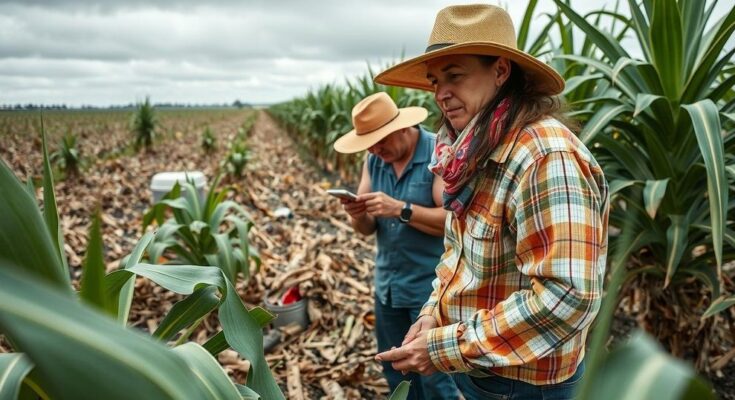In the aftermath of Hurricane Helene, Georgia farmer Chris Hopkins faces overwhelming losses as he struggles to recover from the storm’s devastation. Estimated agricultural damages may exceed $10 billion across the South, prompting emergency assistance from state and federal sources. Farmers, including those in the poultry industry, are appealing for immediate aid as they navigate the re-building process amid significant financial strain.
Chris Hopkins, a farmer in Lyons, Georgia, continues to confront the aftermath of Hurricane Helene, which devastated his farm over two months ago. Torn equipment and broken tree limbs remain scattered across his property, emblematic of the destruction wrought by the storm that struck as a Category 4 hurricane. Estimates indicate that the economic toll of Helene on farmers and agribusinesses from Florida to Virginia may surpass $10 billion, with Georgia’s losses alone amounting to at least $5.5 billion. Many farmers, overwhelmed by the damage, are questioning their future in agriculture.
As Helene made landfall in late September, the immense pressure on farmers intensified. Many, including cotton growers such as Mr. Hopkins, found themselves unable to complete crop cleanup efforts, hindering their ability to salvage their harvest. Mr. Hopkins reported that at least 50% of his cotton from 1,400 acres was lost, translating into substantial financial strain. Even with insurance, he anticipates not recovering an estimated $430,000 in losses from this single crop.
The impact of Hurricane Helene extended well beyond physical crop loss. The storm resulted in destroyed equipment, uprooted timber, and various indirect economic repercussions affecting processing plants and operational productivity. The poultry industry, heavily reliant on local farmers, also faced immense challenges, with significant losses reported from destroyed chicken houses and the subsequent inability to meet various demands.
In response to the disaster, Georgia’s government allocated emergency funds amounting to $100 million to support affected farmers. However, state legislation constrains direct disaster aid to individuals. On a federal level, recent legislation has earmarked $21 billion in disaster assistance to farmers nationwide, underscoring the urgent need for timely aid in recovery efforts, especially as farmers like Jeffrey Pridgen, who experienced significant infrastructure loss, are forced to restart essentially from scratch.
Despite catastrophic losses, analysts indicate that the effect on consumer pricing may remain minimal, as agricultural production from unaffected areas could largely balance any shortages. Nonetheless, specific commodities, such as pecans, may experience noticeable price fluctuations due to Georgia’s dominant production role. As agricultural communities begin their long journey towards recovery, the resilience of farmers in the face of such adversities will be critical.
Hurricane Helene struck the southern United States in late September 2023, causing catastrophic damage to crops, farmlands, and infrastructure. As a Category 4 hurricane, it made landfall in Florida and subsequently moved through Georgia and surrounding states. The storm’s repercussions have presented substantial economic challenges, with estimates suggesting losses for farmers and agribusinesses may reach upwards of $10 billion across multiple states. This crisis primarily impacts the cotton, poultry, and timber industries, prompting both state and federal assistance efforts while raising significant concerns about the future viability of affected farms and farming practices in the region.
Hurricane Helene’s aftermath continues to significantly impact farmers in the Southern United States, with many grappling with devastating losses and emotional turmoil. With economic damages estimated at $10 billion, recovery efforts are underway but fraught with challenges due to state legislation and the need for quick, effective federal support. As various agricultural sectors begin the recovery process, the long-term implications of the storm on production and pricing dynamics will unfold in the months ahead.
Original Source: brookingsregister.com




